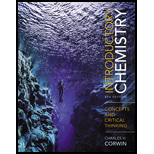
Concept explainers
(a)
Interpretation:
The electronegativity difference in the
Concept introduction:
Electronegativity is defined as the tendency of an atom to attract electrons towards it. Polarized bonds are a result of the electronegativity difference between bonding atoms. The more electronegative atom acquires a partial negative charge and the less electronegative atom acquires partial positive charge while showing charge distribution.
(b)
Interpretation:
The electronegativity difference in the
Concept introduction:
Electronegativity is defined as the tendency of an atom to attract electrons towards it. Polarized bonds are a result of the electronegativity difference between bonding atoms. The more electronegative atom acquires a partial negative charge and the less electronegative atom acquires partial positive charge while showing charge distribution.
(c)
Interpretation:
The electronegativity difference in the
Concept introduction:
Electronegativity is defined as the tendency of an atom to attract electrons towards it. Polarized bonds are a result of the electronegativity difference between bonding atoms. The more electronegative atom acquires a partial negative charge and the less electronegative atom acquires partial positive charge while showing charge distribution.
(d)
Interpretation:
The electronegativity difference in the
Concept introduction:
Electronegativity is defined as the tendency of an atom to attract electrons towards it. Polarized bonds are a result of the electronegativity difference between bonding atoms. The more electronegative atom acquires a partial negative charge and the less electronegative atom acquires partial positive charge while showing charge distribution.
Want to see the full answer?
Check out a sample textbook solution
Chapter 12 Solutions
Introductory Chemistry: Concepts and Critical Thinking Plus MasteringChemistry with eText -- Access Card Package
- Show how each chemical change obeys the octet rule. (a) Hydrogen forms H2 (hydride ion)arrow_forwardWhich of the following has the lowest electronegativity? (a)Sodium (Na) (b)Carbon (C) (c) All of these have the exact same electronegativity. (d)Hydrogen (H) (e)Sulfur (S)arrow_forward18.) Choose all the statements that are correct. (1) Like atomic size, electronegativity decreases going across a period and increases going down a group. (2) The second most electronegative element is chlorine. (3) Electronegativity is directly proportional to atomic number. (4) Like ionization energy, electronegativity increases going across a period and decreases going down a group. (5) Electronegativity is a measure of the ability of an atom to attract electrons and form a negative ion. (6) Electronegativity is a measure of the ability of an atom in a molecule to attract electrons go itself. (7) Electronegativity was first proposed by Linus Pauling. Group of answer choices (2) (1) (4) (3) (5) (7) (6)arrow_forward
- Which of the following is a resonance structure of compound X? N (A) OH NH (B) X NH O NH (C) N (D)arrow_forwardPerchloric acid and its salts are the most stable oxyacids and oxyanions. True or false?arrow_forwardDraw Lewis structures for the following molecules and ion. (c) H2O2 (a) NCl3 (b) OCS (d) HCOO−arrow_forward
- Write the Lewis structures for the following, and include resonance structures where appropriate. Indicate which has the strongest carbon-oxygen bond.(a) CO2(b) COarrow_forwardGive reasons which is correct. And give reasons why other options are incorrect. Note:- Hand written solutions are strictly prohibited.arrow_forwardWrite a Lewis diagram for I-3, the linear (tri-iodide) ion.arrow_forward
- Write the Lewis structure for carbonate ion.arrow_forwardTrue or False: The three most electronegative elements on the periodic table are fluorine, oxygen, and nitrogen.arrow_forwardCompare the magnitude of the lattice energy for each of the following two ion pairs. (a) Ni²+ and O²- separated by a distance of 220 pm (b) Mn²+ and O²- separated by a distance of 431 pmarrow_forward
 Introduction to General, Organic and BiochemistryChemistryISBN:9781285869759Author:Frederick A. Bettelheim, William H. Brown, Mary K. Campbell, Shawn O. Farrell, Omar TorresPublisher:Cengage Learning
Introduction to General, Organic and BiochemistryChemistryISBN:9781285869759Author:Frederick A. Bettelheim, William H. Brown, Mary K. Campbell, Shawn O. Farrell, Omar TorresPublisher:Cengage Learning Chemistry by OpenStax (2015-05-04)ChemistryISBN:9781938168390Author:Klaus Theopold, Richard H Langley, Paul Flowers, William R. Robinson, Mark BlaserPublisher:OpenStax
Chemistry by OpenStax (2015-05-04)ChemistryISBN:9781938168390Author:Klaus Theopold, Richard H Langley, Paul Flowers, William R. Robinson, Mark BlaserPublisher:OpenStax

